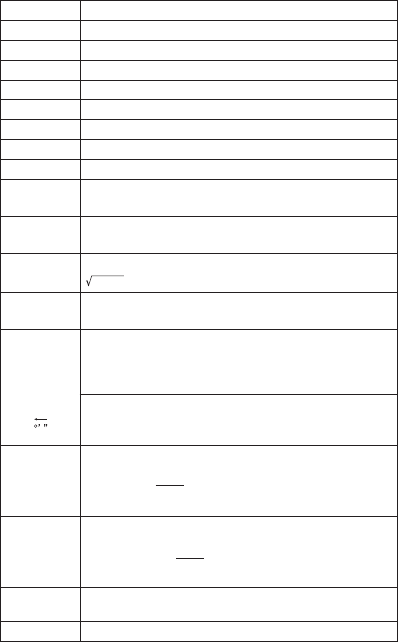
E-39
tanh
–1
x
0 \x\ 9.999999999 s10
–1
logx/lnx
0 x 9.999999999 s10
99
10
x
–9.999999999 s10
99
x 99.99999999
e
x
–9.999999999 s10
99
x 230.2585092
'
x
0 x 1 s10
100
x
2
\x\ 1 s10
50
x
–1
\x\ 1 s10
100
; x & 0
3
x
\x\ 1 s10
100
x!
0 x 69 (x is an integer)
nPr
0 n 1 s10
10
, 0 r n (n, r are integers)
1 {
n!/(n–r)!} 1 s10
100
nCr
0
n 1 s10
10
, 0 r n (n, r are integers)
1 n!/r! 1 s10
100
or 1 n!/(n–r)! 1 s10
100
Pol(x, y)
\x\, \y\ 9.999999999 s10
99
x
2
+
y
2
9.999999999 s10
99
Rec(r, θ)
0
r 9.999999999 s10
99
θ: Same as sinx
°’ ”
\
a\, b, c 1 s10
100
0 b, c
The display seconds value is subject to an error of 21 at
the second decimal place.
\x\1 s10
100
Decimal j Sexagesimal Conversions
0°00˝ \x\ 9999999°5959˝
x
y
x0: –1 s10
100
ylogx 100
x= 0: y 0
x 0: y = n,
m
2
n
+1
(m, n are integers)
However: –1 s10
100
ylog \x\100
x
y
y
0: x & 0, –1 s10
100
1/x logy 100
y= 0: x 0
y 0: x = 2n+1,
2
n
+1
m
(m & 0; m, n are integers)
However: –1 s10
100
1/x log \y\100
a
b
/
c
Total of integer, numerator, and denominator must be 10
digits or less (including division marks).
RanInt#(
a, b)
a b;
\
a
\
,
\
b
\
1 s10
10
; b – a 1 s10
10
• Precision is basically the same as that described under “Calculation Range
and Precision”, above.
•
x
y
,
x
'
y
,
3
, x!, nPr, nCr type functions require consecutive internal
calculation, which can cause accumulation of errors that occur with each
calculation.
• Error is cumulative and tends to be large in the vicinity of a function’s singular
point and inflection point.


















